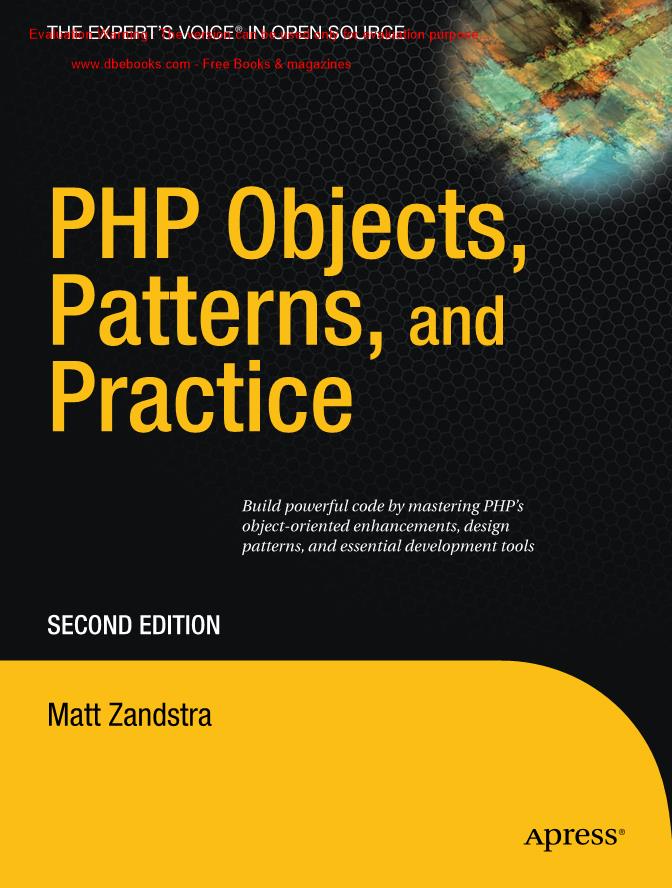《PHP Objects Patterns and Practice_Matt Zandstra》pdf电子书免费下载
下载方式一:
百度网盘下载地址:https://pan.baidu.com/s/1Rfxyl7VA2_GCN6kb39k09w
百度网盘密码:1111
下载方式二:
http://ziliaoshare.cn/Download/af_124091_pd_PHPObjectsPatternsandPractice_MattZandstra.zip
|
|
作者:empty 页数:514 出版社:empty |
《PHP Objects Patterns and Practice_Matt Zandstra》介绍
About the AuthorI MATT ZANDSTRA has worked as a web programmer, consultant, and writer for over a decadeHe is the author of SAMS Teach Yourself PHP in 24 Hours(three editions] and a contributor toDHTML Unleashed.He has written articles for Linux Magazine.Zend.com, IBM DeveloperWorks,and php l architect Magazine, among others.Hisblogcanbefoundathttp://getinstance.comHe is a senior developer at Yahoo!in California.Because it has been so long since he has had any spare time, he only distantly recollects thathe runs regularly to offset the effects of his liking for pubs and cafes and for sitting aroundreading and writing fiction.He doesn't appear to have lost any weight since the first edition,Matt works primarily with PHP Per, and Java, buiding web and commandline applications.Matt lives in SanFrancisco with his wife, Louise, and two children, Holly and Jake.however.
About the Technical ReviewerI TO LAN BLUNDELL is a partner, consultant and developer at B GZ Consult ans, a company spe-cia izing in server-side applications, primarily delivered via the Web.He has been workingwith PHP in particular for seven years and was very glad when it gained strong object support,He lives in Barcelona, Spain, which he hopes to see one day if he sever freed from his desk
《PHP Objects Patterns and Practice_Matt Zandstra》目录
Contents at a Glance
About the Author.
About the Technical Reviewer.
Acknowledgments.
Introduction to the First Edition.
Introduction to the Second Edition.
PART 1mmm Introduction
CHAPTER 1PHP:Design and Management.
PART 2mmm Objects
CHAPTER 2PHP and Objects.
CHAPTER 3Object Basics.
CHAPTER 4Advanced Features.
CHAPTER 5Object Tools.
CHAPTER 6Objects and Design.
PART 3mm Patterns
CHAPTER 7
CHAPTER 8
CHAPTER 9
What Are Design Patterns?Why Use Them?.
Some Pattern Principles.
Generating Objects.
H CHAPTER 10 Patterns for Flexible Object Programming.
CHAPTER 11 Performing and Representing Tasks.
CHAPTER 12 Enterprise Pat tems.
CHAPTER 13DatabasePattemns.
PART 4mmm Practice
CHAPTER 14 Good(and Bad) Practice.
CHAPTER 15An Introduction to PEAR.
CHAPTER 16 Generating Documentation with phpDocumentor.
CHAPTER 17 Version Control with CVS.
CHAPTER 18 Testing with PHPUnit.
CHAPTER 19 Automated Build with Phing.
PART 5mmm Conclusion
I CHAPTER 20 Objects, Pat tems, Practice.
PART 6m Appendixes
APPENDIX ABibliography.
APPENDIX BA Simple Parser.
INDEX.
PHP:Design and Management.
The Problem.
PHP and Other Languages.
About This Book.
Objects.
Pat tems.
Practice.
A FirstClass.
A First Object(or TWo) .
Creating a Constructor Method.
Primitive Types.
Taking the Hint:Object Types.
The Inheritance Problem.
Working with Inheritance.
Exceptions.
PHP and Namespaces.
Include Paths.
Autoload.
What's New in the Second Edition.
Summary.
ObjectS
PHP and Objects.
The Accidental Success of PHP Objects.
Into the Future:PHP 6.
Advocacy and Agno sic is m:The Object Debate.
IntheBeginning:PHP/F.
Syntactic Sugar:PHP 3.
PHP 4 and the Quiet Revolution.
Change Embraced:PHP 5.
Summary.
Object Basics.
Classes and Objects.
Seting Properties in a Class.
Working wth Methods.
Arguments and Types.
Inheritance.
Public, Private, and Protected:Managing Access to
Your Classes.
Summary.
Advanced Features.
St aic Methods and Properties.
Constant Properties.
Abstract Classes.
Interfaces.
Handing Errors.
Final Classes and Methods.
Working with Interceptors.
Defining Destructor Methods.
Copying Objects with__clone) .
Defining String Values for Your Objects.
Summary.
Object Tools.
PHP and Packages.
Looking for Classes.
Responsibilty.
Cohesion.
Coupling.
Orthogon a ity.
Code Duplication.
The Problem.
The Solution.
Consequences.
The Problem.
Using Composit n.
The Problem.
Loosening Your Cou pig
Learning About an Objector Class.
Learning About Methods.
Learning About Properties.
Learning About Inheritance.
Method Invocation.
GettingStarted.
Time to RollUp Your Sleeves.
Examining a Class.
Examining Methods.
Examining Method Arguments.
Using theRe l lection API.
Summary.
Objects and Design.
Defining Code Design.
Object-Oriented and Procedural Programming.
Choosing Your Classes.
Polymorphism.
Encapsulation.
Forget Howto Dolt.
Four Signposts.
The UML.
What Are Design Patterns?Why Use Them?.
The Class Who Knew Too Much.
The Jack of All Trades.
Conditional
